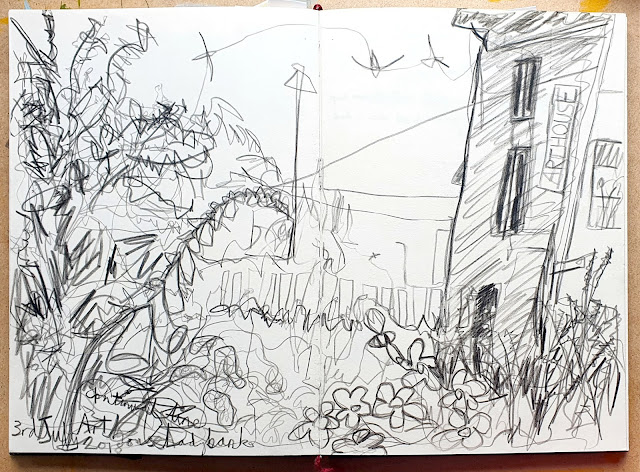Art can be hard. It can be hard to motivate yourself to get started and it can be hard to decide what to draw. (/paint/sculpt/collage... even deciding that can be hard!)
Here are a couple of often used techniques which might help if you ever feel this way.
At art college we did lots of this sort of thing but as the years passed gradually I let it slip. I was strongly reminded of the value of such exercises when I treated myself to a printmaking summerschool tutored by my great friend artist Kittie Jones in 2018. The week took place at Off The Rails Arthouse at Ladybank railway station in Fife.
Try these techniques for yourself, perhaps before getting started on a day of art, if you're feeling bored one evening, or simply as a stand-alone bit of drawing. I find both techniques really relaxing - meditative even - though depending on my mood it can take quite some time to start feeling that way.
Try the techniques indoors, try them in a garden, try them in a park.
Try giving yourself a time limit - one minute (yes, that's short! but try it), then two, then five, then ten. Try half an hour. Try it open-ended.
--------------------------
Technique 1 - Continuous Line
- pick your tool - pencil or pen probably
- make your entire drawing WITHOUT lifting the tool from the paper AT ALL.
- try it with a landscape, a still life, a portrait.
See mine at top of this post.
--------------------------
Technique 2 - Draw What You Hear
Yes, what you hear.
Give it a try. Quite a few tries actually. To start with I found this so hard. I remember feeling almost embarrassed when Kittie asked us to do it. We were sitting outdoors, dotted around a lovely wooded garden. I had no idea what to draw, how to draw it. How do you draw sound??
It was a sunny day, bees were buzzing.
How do you draw the sound of a bumblebee buzzing??
I tried a zigzaggy line. That felt wrong.
Bumblebees are soft, fuzzy, cuddly even (especially Carder bees). Next time one buzzed by I drew a spiralling line, as on a ring-bound calendar. That felt right.
I started to get into it. Swifts were screeching, House martins and swallows were twittering. Footsteps on gravel. Trains stopping. A lorry passing. Woodpigeons coo-cooing. House sparrows chattering.
By the end I couldn't believe how satisfying I found it, and how much time had passed.
Here are the two drawings I heard that day:
What's it like to try this in a quiet room? On a noisy street? When the tv or radio is on? While your toddler plays with her Duplo? When it's pouring with rain. When a storm is blowing under your slates...
Let me know what you think and let me know if you have any other techniques you find helpful for getting you started.






























